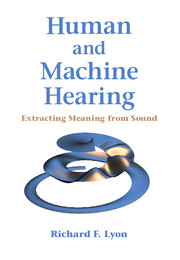Book contents
- Frontmatter
- Dedication
- Contents
- Foreword
- Preface
- Part I Sound Analysis and Representation Overview
- Part II Systems Theory for Hearing
- 6 Introduction to Linear Systems
- 7 Discrete-Time and Digital Systems
- 8 Resonators
- 9 Gammatone and Related Filters
- 10 Nonlinear Systems
- 11 Automatic Gain Control
- 12 Waves in Distributed Systems
- Part III The Auditory Periphery
- Part IV The Auditory Nervous System
- Part V Learning and Applications
- Bibliography
- Author Index
- Subject Index
- Plate section
12 - Waves in Distributed Systems
from Part II - Systems Theory for Hearing
Published online by Cambridge University Press: 28 April 2017
- Frontmatter
- Dedication
- Contents
- Foreword
- Preface
- Part I Sound Analysis and Representation Overview
- Part II Systems Theory for Hearing
- 6 Introduction to Linear Systems
- 7 Discrete-Time and Digital Systems
- 8 Resonators
- 9 Gammatone and Related Filters
- 10 Nonlinear Systems
- 11 Automatic Gain Control
- 12 Waves in Distributed Systems
- Part III The Auditory Periphery
- Part IV The Auditory Nervous System
- Part V Learning and Applications
- Bibliography
- Author Index
- Subject Index
- Plate section
Summary
The movement of waves down the basilar membrane is analogous to the propagation of light waves in a medium of continuously changing index of refraction. While the velocity of light varies as it travels through the substance, substantial reflections will not occur as long as the index of refraction changes slowly enough.
—“The cochlear compromise,” Zweig, Lipes, and Pierce (1976)The cochlea is not a system of lumped elements, but rather a distributed system. Distributed systems can be linear or nonlinear; before we tackle the cochlea, we need to study the simpler linear case. Linear system theory is still applicable to distributed systems, as it is to systems of lumped elements—but it gets a bit more complicated because the transfer functions are not as simple as ratios of polynomials, and because signals are functions of location, not just of time.
The spatially distributed state of a distributed system is typically described as a wave, a function of continuous time and space, rather than in terms of inputs and outputs. We can conceptually look at the system response (transfer function or impulse response or frequency response) at an infinite number of outputs at a continuum of locations, or at a finite set of outputs at discrete locations, with the wave at some unique location as input.
Systems of lumped elements, having a finite number of degrees of freedom, are described by ordinary differential equations that relate the rate of change of each state variable to the state and inputs of the system. In a distributed system, the motion (displacement, velocity, pressure, current, voltage, or whatever) of every point along a continuum of one or more dimensions is part of the state, so such systems are described by partial differential equations, in which rates of change with respect to both time and space are involved. In this chapter, we do not involve ourselves much with partial differential equations directly, but rather discuss what their solutions tell us about waves.
- Type
- Chapter
- Information
- Human and Machine HearingExtracting Meaning from Sound, pp. 219 - 236Publisher: Cambridge University PressPrint publication year: 2017
- 2
- Cited by



